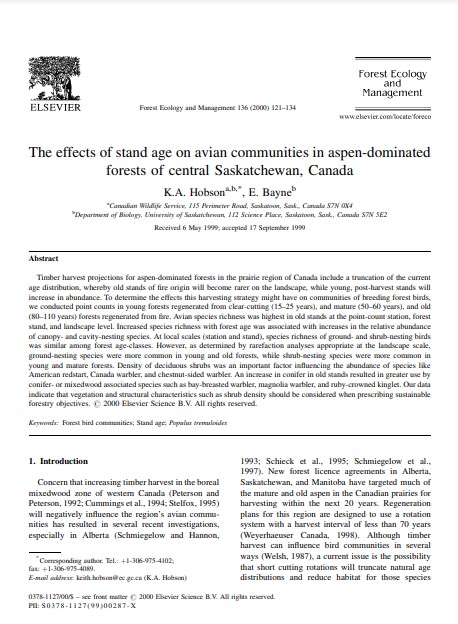The effects of stand age on avian communities in aspen-dominated forests of central Saskatchewan, Canada
Bosque Modelo:
Prince Albert
Temática:
Conservación
Tipo de documento:
Artículo científico
Resumen
Timber harvest projections for aspen-dominated forests in the prairie region of Canada include a truncation of the current age distribution, whereby old stands of ®re origin will become rarer on the landscape, while young, post-harvest stands will increase in abundance. To determine the effects this harvesting strategy might have on communities of breeding forest birds, we conducted point counts in young forests regenerated from clear-cutting (15±25 years), and mature (50±60 years), and old (80±110 years) forests regenerated from ®re. Avian species richness was highest in old stands at the point-count station, forest stand, and landscape level. Increased species richness with forest age was associated with increases in the relative abundance of canopy- and cavity-nesting species. At local scales (station and stand), species richness of ground- and shrub-nesting birds was similar among forest age-classes. However, as determined by rarefaction analyses appropriate at the landscape scale, ground-nesting species were more common in young and old forests, while shrub-nesting species were more common in young and mature forests. Density of deciduous shrubs was an important factor in¯uencing the abundance of species like American redstart, Canada warbler, and chestnut-sided warbler. An increase in conifer in old stands resulted in greater use by conifer- or mixedwood associated species such as bay-breasted warbler, magnolia warbler, and ruby-crowned kinglet. Our data indicate that vegetation and structural characteristics such as shrub density should be considered when prescribing sustainable forestry objectives. # 2000 Elsevier Science B.V. All rights reserved.
Información Bibliográfica
Autor:
Hobson, KA and E Bayne.
Revista:
Forest Ecology and Management
Año:
2000
N°:
1 . 2
País :
Canadá
Páginas:
121 - 134
Volumen:
136
Idioma:
Ingles
Palabras claves
Forest bird communities; Stand age; Populus tremuloides





